Hello readers, Hope you are enjoying this spring. Here the sun has been resplendent all week and it is hard to stay at a keyboard. You just want to keep dashing outside So in the spirit of things I am sharing some moves that might be useful for keying into the living fabric of Earth, It outlines the dramaturgical ur-practice of The Red Tent, an embodied challenge to the rigid culture of control which represses and diverts the life force of all beings to further its dominion. Also for new subscribers, it contains brief recap of some of the other practices explored in the last year. Just follow the links.
First though, before you step in: feel your feet, take a deep breath, connect with your beating heart, stretch out your arms, put your face to the sun, look up into blue …
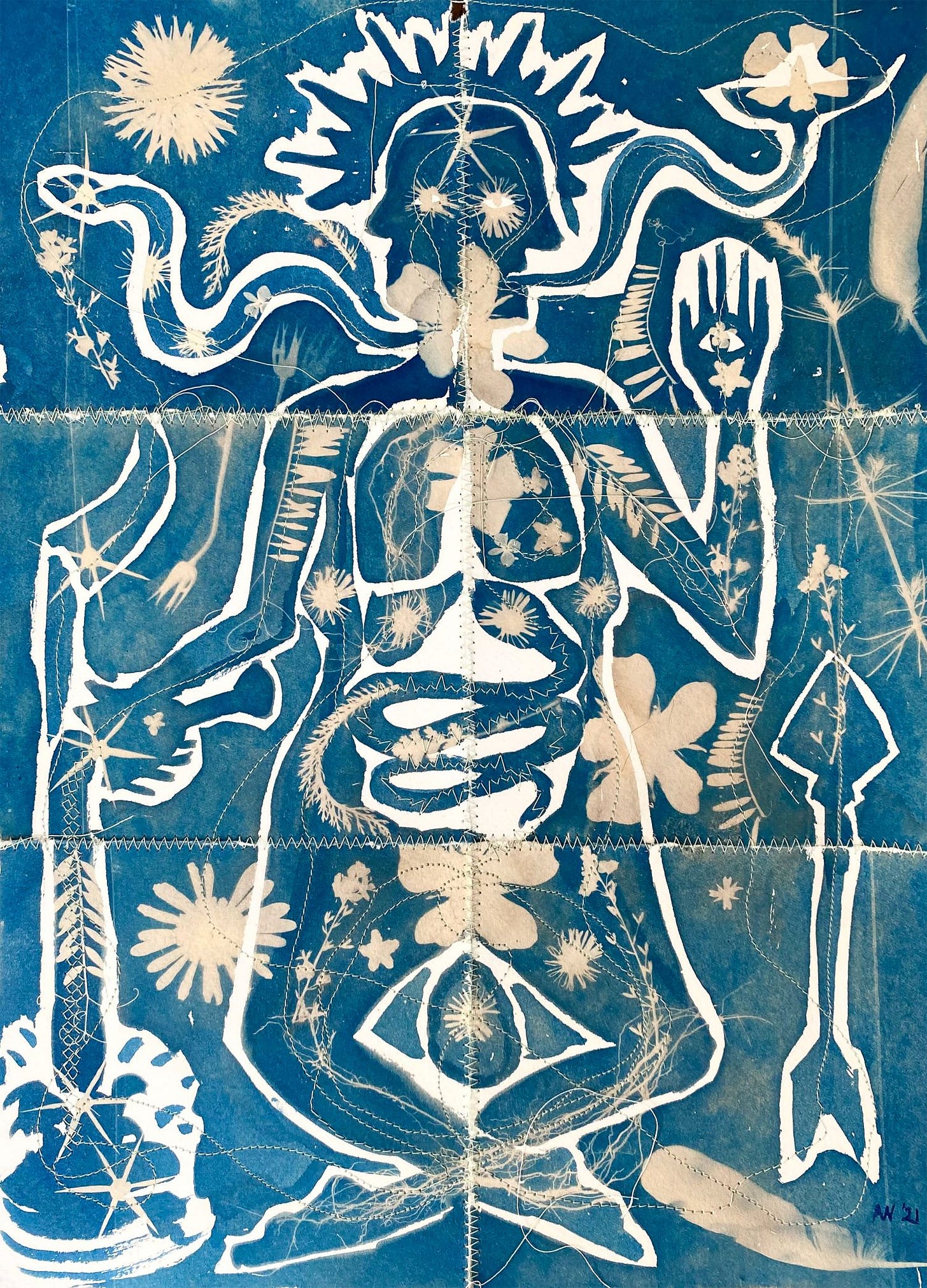
I am a wind on the deep waters,
I am a shining tear of the sun,
I am a hawk on a cliff,
I am fair among flowers,
I am a god who sets the head afire with smoke.
from ‘Song of Amergin’
I don’t know why I do this: stop by the cafe at the farm shop, or this tearoom at the top of the cliff. It is never what you hope it might be: a convivial space, a corner to hang out with a notebook. The atmosphere is always stiff. Polite. Dull. I feel hemmed in by it all and can’t wait to lie down beside the ditch of shining lesser celandines, or here under the lea of the cliff beside the crinkly purple sea kale, with the sand martins swooping above my head, my feet in the cold sparkling water.
Leaping onto my bike, I burst into song, breaking out of restriction, singing to the heath, the light on the sea, the exorbitant scent of gorse on the air. I don’t even recognise the language that is coming out of my mouth.
It’s then I remember how Mark once led a singing group of cooks around a Mexican supper we had all made for a community meal called Happy Mondays.
Porque cantando se alegran cielito lindo los corazones
Because, sweet sky, singing gladdens the heart
Heart is what is missing.
The class
Last week I gave a class on perception and interacting with the land. As usual I had asked everyone to walk a territory in the spirit of invitation and find an object to introduce themselves and the place. So in preparation I went down to the river. As I stood there on the bridge, sleeping waterlily roots swirling below my feet, I found myself speaking out loud what I was going to say later that evening.
Here, I said, you can tap into the rio abajo rio, the river beneath the river, the mythos held within the form of place: eels swimming in geological time, the god Bran in the underworld alder trees, the equinox bridge, crossing from the winter dreaming self to the outer warrior of spring.
Somehow those three co-ordinates created an anchorage that gave me to access to what the Okanagan people call a human being, a ‘land-dreaming capacity’, what a person’s presence is doing in a place. Speaking with and for all beings in the territory.
Someone once told me, you can find anywhere in the world, so long as you know the three words of their location. So later that evening, I asked everyone to draw a map of their walk and mark three portals: where did you linger, what crossed your path, what spoke to you?
What has this to do with being dramaturgical you might ask? This is because when you go to a place with an intent to hold a dialogue, those communications come through your whole living being, not just your eyes and mind. In the visiting of a plant or place you are setting up conditions for an encounter and staying until something happens – a shift of thought, mood, feeling, memory – that you then recognise as a connection, either there, or later or in a dreaming. This attention is what we cultivate with the body. You cannot do this with your mind. You cannot do this without engaging your heart, without making a relationship with place. The love goes both ways. This is what the Earth teaches us every day if we listen.
Although I gives classes, I don’t really teach. I just invite people to go down to the river themselves, and experience where they are, to begin an inquiry that can then become a practice. The more you visit, the more adept your practice becomes, the deeper that relationship.
The trick is coming alive and conscious in a place, which is why the first step is to tune in: to feel your feet on the Earth and breathe into your heart. To move your mind away from thinking and align your attention according to the time of the sun. It’s a radical step I tell the class because we live in 24/7 clock time, untethered to the Earth. our lives dictated by the algorithm of civilisation. To root yourself, to move with your whole being in tune with the Earth, is to break its pernicious grip on your mind and will. The more you practice, the less power it has. Not just over you but in the world.
We need to build a shape with our everyday experiences, I told the group. These coordinates will assist you to locate yourself in time and place, in many dimensions, and see beyond your mind’s control of reason and scientific fact.
This is a speaking practice, so when you say those words out loud to your fellows, the world can hear you (the physical voice being part of the body). You put your visit and dreaming into a creative form as a mnemonic, as people have done for millennia –in dance, song, story, ritual and art – so others can follow your steps.
As a writer on the Uneasy Chair, you find your feet in this place in your imagination. stored in the memory of your heart, and write from there. This is a dramaturgical practice because your body is living and breathing, and this dance between dimensions allows you to break out of the force fields of the Labyrinth1.
One of the key shapes in both the Labyrinth and in the Uneasy Chair practices is a figure of eight, or lemniscate in space-time, The gathering of material and returning with gifts aligns us with the feedback loop that allows life to continue. It is a shape the honeybees dance to show their sisters where the pollen of the willows and gorse can be found, according to the direction of the sun. You set out, you encounter, you return and you give back.
‘I went to the cove and saw the sea and the moonlight, and it was beautiful but I became aware it would still be here if I wasn’t, said the young woman from Cornwall in the class.
‘But you did see it,’ I said. ‘All beauty loves to be seen, and when you behold it, it is strengthened, as you are. Paying attention, seeing with your heart, is how we give back.’
I had brought a piece of reindeer lichen to introduce myself. When I held it in my hands and spoke, I realised it could go so many ways: to the quarry where I once walked barefoot across its crunchy surface and felt my feet come alive, to the reindeer that once roamed here and now live in our deep-time imaginations, to the intricacies of a lifeform that is in fact an ancient collaboration between two lifeforms, able that coalition to withstand all kinds of harsh conditions.
But what came to me was the long tailed tit nest in Jane’s garden, a dome woven from spiderwebs and feathers, covered in grey-green tree lichen. How we had sat by her pond with its shawl of frogspawn, under the scented magnolia, and walked through a living library of trees she had planted with her husband. How each of them – birch, cherry, black poplar, goat willow, alder – held a story of a day when they had worked together, stood here looking across the marsh as spring came. It wasn’t much, she said, to tend a garden in times of such calamity. But that depends on how you see that garden, or any act within a territory. How you hold attention, as the land around is ripped up and thousands of trees torn from their roots. As it is across the globe.
What is extraordinary about the nest is that as the chicks grow the nest can expand to hold them, she told me. The fabric moves.
The world is round and wavy
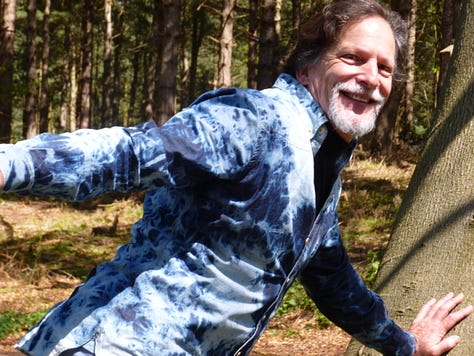
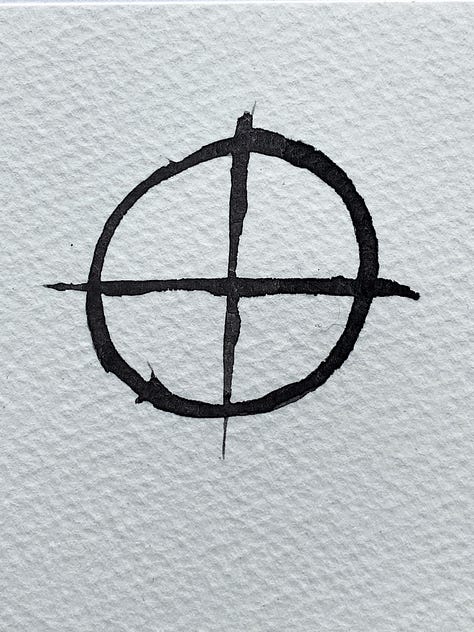
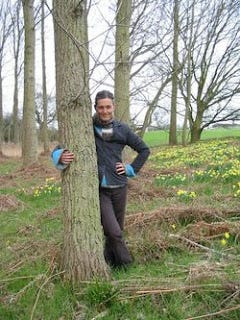
Vilcabamba, Ecuador, 1992. She was Night and I was Dawn. I was deliberating. We were enacting a drama, ushered by San Pedro cactus, the keeper of keys.
’You can have it like this,’ she said and wrapped me in a big black cloak. ‘Or you can have it like this’, and she opened the cloak and there you were, with Tina beside you laughing. It felt as though that decision was the simplest and the most profound thing I could make in my life. It felt as if it could turn the destiny of the whole planet around.
’I'll have it like this,’ I declared.
’Bring it on,’ she said.
Everything we explored with power plants was a performance. Everything was dramaturgical. None of it remained internal. All the journeys began with a question, a decision to make an inquiry. The question formed a structure that enabled us to explore what is sometimes known as the dreaming of the Earth or ‘right-hemisphere’ consciousness. That day it was the four winds (I was the south). Other times it was a myth, a fairy tale, the planets, the ocean, the creatures, the ancestors, that revealed themselves, not only in people’s faces, but in their whole bodies. All of them provoked some kind of liberation, the breaking of enchantment. There were tragedies that turned into comedies, weeping and wailings that transformed into laughter; autocratic rulers softened and become allies, historic enemies forgot their quarrels; cities dissolved, our bodies once bound by terrors, danced and sang. Once you turned into a wooden puppet and it took all night for us to find enough warmth and movement so you could return to your human form.
Mostly we knew when a spell had been broken because something stiff and cruel had found its heart again. When we stepped out of the squares and straight lines that held us captive, and remembered the world that was round and wavy.
But one day the shows ended. The travelling stopped. The inquiry stopped. The ancestral mountains, our companions, disappeared, and we found ourselves in the flatlands, in the place of tearooms and industrial dereliction. The practice began. Where the power plants provide a bridge across the divide between dimensions, allowing you to see the cosmic ramifications of every small move, in the practice you have to make that bridge yourself. You have to expand those layers of perception on your own: opening and knowing the land in terms of your kin, the mythos, the Earth. It requires work, what Gurdjieff in his rigorous teaching called ‘being-effort’.
We are in a place of show. This Earth is where our appearance in the light happens, our spring. Where you put yourself on the line and reveal a capacity to be protean, to embody many things. But what kind of show can that be in a world where only a superficial configuration of human being is tolerated? Where the dramaturgical act is only understood as a source of entertainment?
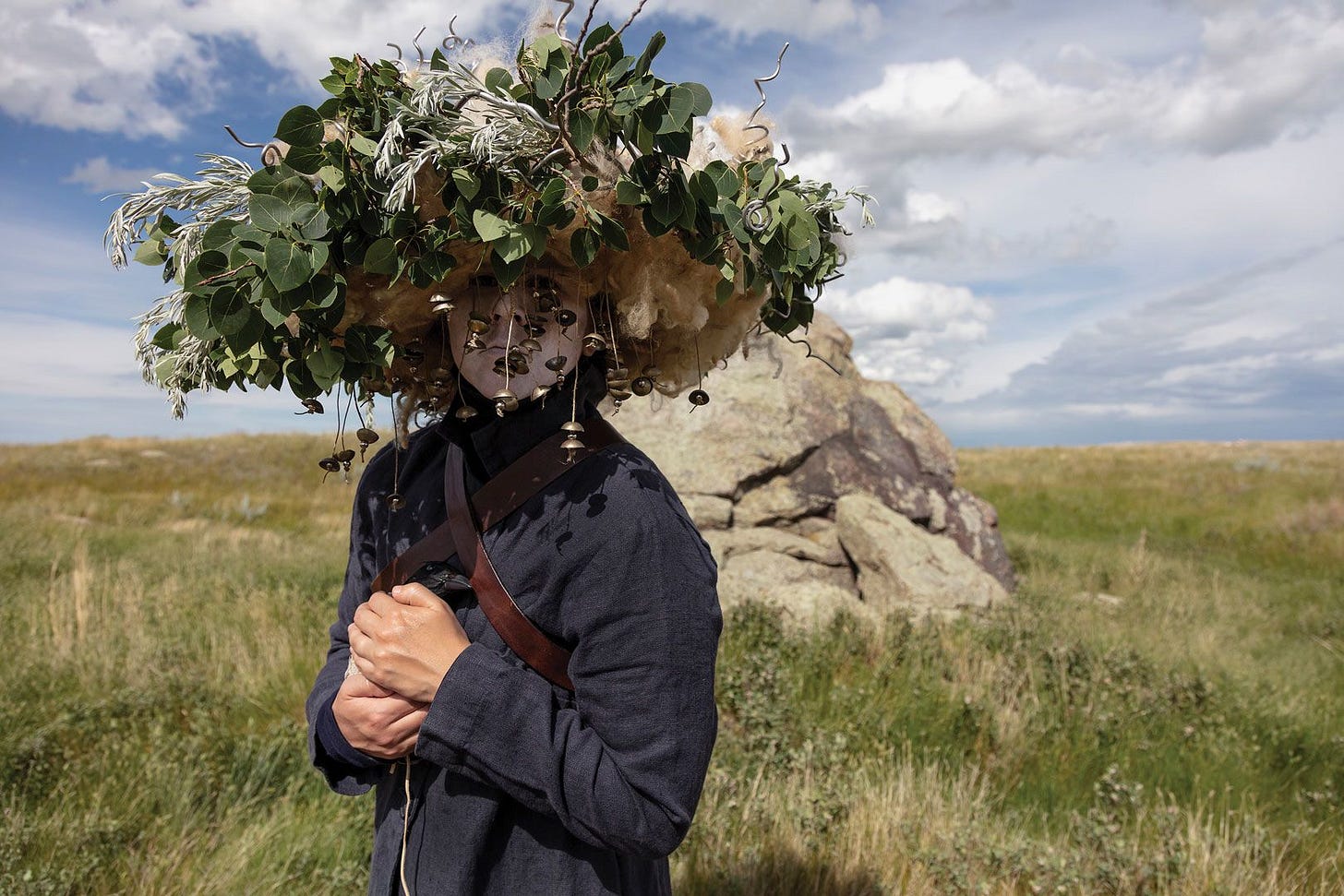
I have danced the Cailleach with a giant hat full of bracken and owl feathers, as the people came up the hill.
I have been a heron in the reeds in the darkness, as the people crossed the river.
I have been a raven on the mountain in the sun.
I have jumped the eight fires and danced the four directions.
I have stepped into the labyrinth as Ariadne in a theatre in Germany
I have stepped through the gates of the kur as Inanna in an English church.
When I was the Earth, I laughed, and said: if you can’t dance what are you doing on my planet?
Teaching a class about the seven doors of the Underworld, we sit in the dark, holding a card from a practice called The Earth Game. As the light fades in the back room of the college cafeteria, people stand up and embody what element of Earth is on the card – waterbird, fen, mountain, north wind – without revealing its name, which we then have to discover. What is remarkable is that everyone can do this. The words that emerge from our mouths are shaped like an ancient riddle, a question that increases in aliveness as we go around the room. What am I?
The once and future kingdom
A writer and gardener sent a piece to Dark Mountain this week that concerned a misunderstanding of what ‘nature’ was, which was distinct from life, and our love of it. In the essay, there was an intriguing statement: life, he wrote, fights the entire universe, those energies of electro-magnetism, gravity, weak and strong nuclear force.
And somehow, something fell into place. Instead of seeing our push against the world’s heartlessness as failing to bring about the peaceable kingdom, the once and future world, instead perhaps to realise this fight against the impersonal forces of destruction is what life itself does. She dances, and fixed things either change, or stiffen more in resistance. The deer does not overpower the predator, and bring justice to the forest, she produces another fawn. Our challenge as humans is to know we are life in synch with the planet of life, where the knowledge of change and regeneration is stored. Not to give into powerlessness, and submit to those forces and fuel them further. Which is a core teaching you find in all Earth-based myths and fairy tales.
But, you might say, exasperated: what is the practice? These links take me to posts but I have to sift through them to find any instruction. There is too much territory and not enough map! Dear reader, this is the point: the links go every which way because it is not a linear practice, and this is not a linear column. It is a way of engaging in the non-linear collaborative world: a dance of many directions. The directions are embedded in places and times, in everyday stories, of fires and flowers, sorrow and laughter, because that is how life is.
I could just tell you: go into the Labyrinth and come back, embody the goddess Ariadne, just open and don’t close the door! But you and I would be no wiser. People have revelations all the time on mountains, with power plants, they go to retreats and then return empty handed to the world ‘of anger and telegrams’ as E.M. Forster once put it. Somehow you have to bridge what you once saw to make sense in ordinary life. To have a practice of many steps helps embed the invisible in the visible. Keeps things remembered and true to origin. This is how we weave the worlds back together, keep everything linked up, communicating, aligned with our dancing nature.
Just open means many things but mostly it requires you to live in your heart, which hurts because we are losing so much in this fight, sometimes without knowing it: our one-time freedoms, old trees, clean rivers, this battered coastline. But as someone who has lost her greatest ally, I have still to gladden and love the world. The crescent moon as it appears above the treeline at evening, the thrushes singing at first light, these green leaves on my supper plate. I have still to go out to the lane this morning to gather white violets for Mark, to sit beside the henbits he so loved, shining in the sun before they are mown. I have still to put my hands in the earth and plant the seeds he left behind: the seeds that hold the past and future, night and dawn.
We still have to bring it on.
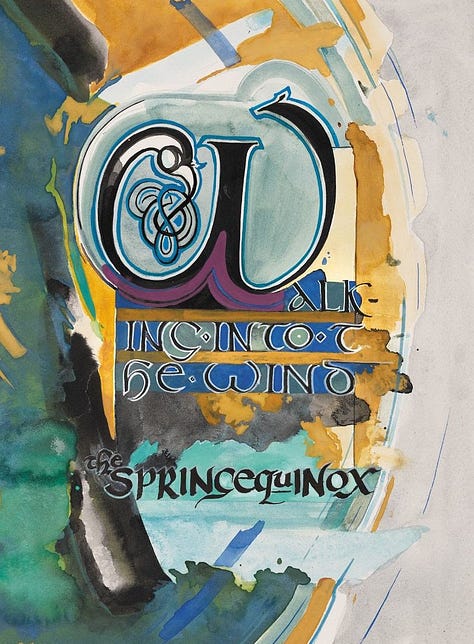
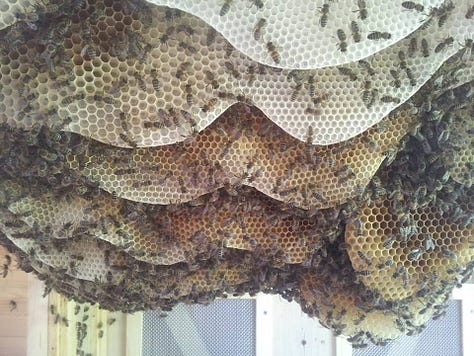

AN INVITATION
You are invited to a celebration of the next Dark Mountain anthology on ‘Bodies’.
Being a collection of writing and artwork on things bodily and broken, mended and mysterious, individual and collective, interrelated and entwined;
An anthology of the corporeal in times of crisis, collapse and change;
A repository of the creaturely, the cellular and the planetary;
An assemblage of anatomies shapeshifting and changing form;
Containing dancers’ bodies in flow, activist bodies on the line, bodies that do not conform, bodies in resistance to industrial disembodiment;
Of bones, blood, sinews, chitin, lignin, fur, stone, roots and leaves;
Of birth, growth, sickness, healing, death, disappearance and renewal;
Of chronos, kairos, circadian rhythms, the diurnal and nocturnal;
Of bonds and boundaries and the spaces in between.
Do join us for the online launch of Dark Mountain: Issue 27 on Wednesday 23rd April, starting at 7:30pm (BST) to hear from some of the bodies – writers, artists, editors and others – who have contributed to the book from around the world.
Dark Mountain: Issue 27 will be published on 17th April 2025
Hope to see you there!
Tickets are free but you will need to book a place on Eventbrite here.
A strand in The Red Tent that follows the four steps of encounter, coming to meet, return and emergence.





Utterly transformational. I read this in a quiet place and it was like looking through a misted window that I then opened and the full force of the call to leave the building comes through. Thank you so much for writing and posting it